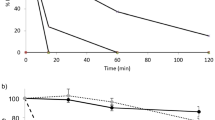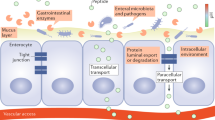Abstract
A major disadvantage associated with current diabetes therapy is dependence on injectables for long-term disease management. In addition to insulin, incretin hormone replacement therapies including exenatide have added a new class of drugs for Type-2 diabetes. Although efficacious, patient compliance with current diabetic therapy is poor due to requirement of injections, inability to cross the intestinal epithelium and instability in the gastrointestinal tract. Here, we report the efficacy of a mucoadhesive device in providing therapeutic concentrations of insulin and exenatide via oral administration. Devices were prepared with a blend of FDA-approved polymers, carbopol, pectin and sodium carboxymethylcellulose, and were tested for drug carrying capability, in vitro release, Caco-2 permeability, and in vivo efficacy for insulin and exenatide. Results suggested that mucoadhesive devices successfully provided controlled release of FITC-insulin, released significant amounts of drug, while providing noteworthy enhancement of drug transport across Caco-2 monolayers without compromising monolayer integrity. In-vivo administration of the devices provided significant enhancement of drug absorption with 13- and 80-fold enhancement of relative bioavailability for insulin and exenatide compared to intestinal injections with significant increase in half-lives, thus resulting in prolonged blood glucose reduction. This study validates the efficacy of mucoadhesive devices in promoting oral peptide delivery to improve patient compliance and dose adherence.










Similar content being viewed by others
References
Ahn, S., I. H. Lee, E. Lee, H. Kim, Y. C. Kim, and S. Jon. Oral delivery of an anti-diabetic peptide drug via conjugation and complexation with low molecular weight chitosan. J. Control Release 170:226–232, 2013.
Al-Tabakha, M. M. Future prospect of insulin inhalation for diabetic patients: the case of Afrezza versus Exubera. J. Control Release 215:25–38, 2015.
American Diabetes Association. Standards of medical care in diabetes-2011. Diab. Care 34: S11–S61, 2011.
Cahn, A., R. Miccoli, A. Dardano, and S. Del Prato. New forms of insulin and insulin therapies for the treatment of type 2 diabetes. Lancet Diabetes Endocrinol. 3:638–652, 2015.
Camenisch, G., J. Alsenz, H. van de Waterbeemd, and G. Folkers. Estimation of permeability by passive diffusion through Caco-2 cell monolayers using the drugs’ lipophilicity and molecular weight. Eur. J. Pharm. Sci. 6:317–324, 1998.
Caramella, C. M., G. Sandri, S. Rossi, M. Mori, M. Cristina Bonferoni, F. Ferrari, C. Del Fante, and C. Perotti. New therapeutic platforms for the treatment of epithelial and cutaneous lesions. Curr. Drug Deliv. 10:18–31, 2013.
Castro, P. M., P. Fonte, F. Sousa, A. R. Madureira, B. Sarmento, and M. E. Pintado. Oral films as breakthrough tools for oral delivery of proteins/peptides. J. Control Release 211:63–73, 2015.
Cemeroglu, A. P., A. Can, A. T. Davis, O. Cemeroglu, L. Kleis, M. S. Daniel, J. Bustraan, and T. J. Koehler. Fear of needles in children with type 1 diabetes mellitus on multiple daily injections and continuous subcutaneous insulin infusion. Endocr. Pract. 21:46–53, 2015.
Cervera, A., E. Wajcberg, A. Sriwijitkamol, M. Fernandez, P. Zuo, C. Triplitt, N. Musi, R. A. DeFronzo, and E. Cersosimo. Mechanism of action of exenatide to reduce postprandial hyperglycemia in type 2 diabetes. Am. J. Physiol. Endocrinol. Metab. 294:E846–E852, 2008.
Chaturvedi, K., K. Ganguly, A. R. Kulkarni, W. E. Rudzinski, L. Krauss, M. N. Nadagouda, and T. M. Aminabhavi. Oral insulin delivery using deoxycholic acid conjugated PEGylated polyhydroxybutyrate co-polymeric nanoparticles. Nanomedicine (Lond) 10:1569–1583, 2015.
Chuang, E. Y., K. J. Lin, P. Y. Lin, H. L. Chen, S. P. Wey, F. L. Mi, H. C. Hsiao, C. T. Chen, and H. W. Sung. Self-assembling bubble carriers for oral protein delivery. Biomaterials 64:115–124, 2015.
Chuang, E. Y., G. T. Nguyen, F. Y. Su, K. J. Lin, C. T. Chen, F. L. Mi, T. C. Yen, J. H. Juang, and H. W. Sung. Combination therapy via oral co-administration of insulin- and exendin-4-loaded nanoparticles to treat type 2 diabetic rats undergoing OGTT. Biomaterials 34:7994–8001, 2013.
Fonte, P., F. Araujo, C. Silva, C. Pereira, S. Reis, H. A. Santos, and B. Sarmento. Polymer-based nanoparticles for oral insulin delivery: revisited approaches. Biotechnol. Adv. 33:1342–1354, 2015.
Garcia-Perez, L. E., M. Alvarez, T. Dilla, V. Gil-Guillen, and D. Orozco-Beltran. Adherence to therapies in patients with type 2 diabetes. Diabetes Ther. 4:175–194, 2013.
Gordon Still, J. Development of oral insulin: progress and current status. Diabetes Metab. Res. Rev. 18(Suppl 1):S29–S37, 2002.
Govindasamy, P., B. R. Kesavan, and J. K. Narasimha. Formulation of unidirectional release buccal patches of carbamazepine and study of permeation through porcine buccal mucosa. Asian Pac. J. Trop. Biomed. 3:995–1002, 2013.
Grover, M., and P. Utreja. Recent advances in drug delivery systems for anti-diabetic drugs: a review. Curr. Drug Deliv. 11:444–457, 2014.
Gupta, V., N. Doshi, and S. Mitragotri. Permeation of insulin, calcitonin and exenatide across Caco-2 monolayers: measurement using a rapid, 3-day system. PLoS One 8:e57136, 2013.
Gupta, V., B. H. Hwang, N. Doshi, and S. Mitragotri. A permeation enhancer for increasing transport of therapeutic macromolecules across the intestine. J. Control Release 172:541–549, 2013.
Gupta, V., B. H. Hwang, J. Lee, A. C. Anselmo, N. Doshi, and S. Mitragotri. Mucoadhesive intestinal devices for oral delivery of salmon calcitonin. J Control Release 172:753–762, 2013.
He, H., P. Wang, C. Cai, R. Yang, and X. Tang. VB-coated Gel-Core-SLN containing insulin: another way to improve oral absorption. Int. J. Pharm. 493:451–459, 2015.
Heppner, K. M., and D. Perez-Tilve. GLP-1 based therapeutics: simultaneously combating T2DM and obesity. Front. Neurosci. 9:92, 2015.
Hubatsch, I., E. G. Ragnarsson, and P. Artursson. Determination of drug permeability and prediction of drug absorption in Caco-2 monolayers. Nat. Protoc. 2:2111–2119, 2007.
Jimmy, B., J. Jose, Z. A. Al-Hinai, I. K. Wadair, and G. H. Al-Amri. Adherence to medications among Type 2 diabetes mellitus patients in three districts of Al Dakhliyah Governorate, Oman: A cross-sectional pilot study. Sultan Qaboos Univ. Med. J. 14:e231–e235, 2014.
Kahn, S. E. The relative contributions of insulin resistance and beta-cell dysfunction to the pathophysiology of Type 2 diabetes. Diabetologia 46:3–19, 2003.
Karamanidou, T., K. Karidi, V. Bourganis, K. Kontonikola, O. Kammona, and C. Kiparissides. Effective incorporation of insulin in mucus permeating self-nanoemulsifying drug delivery systems. Eur. J. Pharm. Biopharm. 97:223–229, 2015.
Khafagy el, S., M. Morishita, Y. Onuki, and K. Takayama. Current challenges in non-invasive insulin delivery systems: a comparative review. Adv. Drug Deliv. Rev. 59:1521–1546, 2007.
Lopes, M., S. Simoes, F. Veiga, R. Seica, and A. Ribeiro. Why most oral insulin formulations do not reach clinical trials. Ther. Deliv. 6:1–15, 2015.
Mansourpour, M., R. Mahjub, M. Amini, S. N. Ostad, E. S. Shamsa, M. Rafiee-Tehrani, and F. A. Dorkoosh. Development of acid-resistant alginate/trimethyl chitosan nanoparticles containing cationic beta-cyclodextrin polymers for insulin oral delivery. AAPS PharmSciTech 16:952–962, 2015.
Mazzarino, L., R. Borsali, and E. Lemos-Senna. Mucoadhesive films containing chitosan-coated nanoparticles: a new strategy for buccal curcumin release. J. Pharm. Sci. 103:3764–3771, 2014.
Morishita, M., and N. A. Peppas. Is the oral route possible for peptide and protein drug delivery? Drug Discov. Today 11:905–910, 2006.
Nielsen, E. J., S. Yoshida, N. Kamei, R. Iwamae, S. Khafagy el, J. Olsen, U. L. Rahbek, B. L. Pedersen, K. Takayama, and M. Takeda-Morishita. In vivo proof of concept of oral insulin delivery based on a co-administration strategy with the cell-penetrating peptide penetratin. J. Control Release 189:19–24, 2014.
Peh, K. K., and C. F. Wong. Polymeric films as vehicle for buccal delivery: swelling, mechanical, and bioadhesive properties. J. Pharm. Pharm. Sci. 2:53–61, 1999.
Ponchel, G., and J. Irache. Specific and non-specific bioadhesive particulate systems for oral delivery to the gastrointestinal tract. Adv. Drug Deliv. Rev. 34:191–219, 1998.
Prausnitz, M. R., and R. Langer. Transdermal drug delivery. Nat. Biotechnol. 26:1261–1268, 2008.
Rekha, M. R., and C. P. Sharma. Oral delivery of therapeutic protein/peptide for diabetes–future perspectives. Int. J. Pharm. 440:48–62, 2013.
Remunan-Lopez, C., A. Portero, J. L. Vila-Jato, and M. J. Alonso. Design and evaluation of chitosan/ethylcellulose mucoadhesive bilayered devices for buccal drug delivery. J. Control Release 55:143–152, 1998.
Sheng, J., L. Han, J. Qin, G. Ru, R. Li, L. Wu, D. Cui, P. Yang, Y. He, and J. Wang. N-trimethyl chitosan chloride-coated PLGA nanoparticles overcoming multiple barriers to oral insulin absorption. ACS Appl. Mater. Interfaces 7:15430–15441, 2015.
Sicras-Mainar, A., R. Navarro, L. Ruiz, and R. Morano. Adherence and persistence in patients initiating treatment with injectable therapies for Type 2 diabetes mellitus (T2 dm) in Spain. Value Health 18:A612, 2015.
Smart, J. D. The basics and underlying mechanisms of mucoadhesion. Adv. Drug Deliv. Rev. 57:1556–1568, 2005.
Sun, S., N. Liang, H. Yamamoto, Y. Kawashima, F. Cui, and P. Yan. pH-sensitive poly(lactide-co-glycolide) nanoparticle composite microcapsules for oral delivery of insulin. Int. J. Nanomed. 10:3489–3498, 2015.
Tang, C., Y. X. Guan, S. J. Yao, and Z. Q. Zhu. Preparation of ibuprofen-loaded chitosan films for oral mucosal drug delivery using supercritical solution impregnation. Int. J. Pharm. 473:434–441, 2014.
Tanwani, L. K. Insulin therapy in the elderly patient with diabetes. Am. J. Geriatr. Pharmacother. 9:24–36, 2011.
Tirnaksiz, F., and J. R. Robinson. Rheological, mucoadhesive and release properties of pluronic F-127 gel and pluronic F-127/polycarbophil mixed gel systems. Pharmazie 60:518–523, 2005.
Usansky J., A. Desai, and T.-L. D. PK functions for Microsoft Excel. 2003.
Whitehead, K., N. Karr, and S. Mitragotri. Discovery of synergistic permeation enhancers for oral drug delivery. J. Control Release 128:128–133, 2008.
Whitehead, K., N. Karr, and S. Mitragotri. Safe and effective permeation enhancers for oral drug delivery. Pharm. Res. 25:1782–1788, 2008.
Whitehead, K., Z. Shen, and S. Mitragotri. Oral delivery of macromolecules using intestinal patches: applications for insulin delivery. J. Control Release 98:37–45, 2004.
Wong, C. F., K. H. Yuen, and K. K. Peh. An in vitro method for buccal adhesion studies: importance of instrument variables. Int. J. Pharm. 180:47–57, 1999.
Xu, Q., N. J. Boylan, S. Cai, B. Miao, H. Patel, and J. Hanes. Scalable method to produce biodegradable nanoparticles that rapidly penetrate human mucus. J. Control Release 170:279–286, 2013.
Yim, L. Belonephobia—a fear of needles. Aust. Fam. Phys. 35:623–624, 2006.
Zhang, B., D. He, Y. Fan, N. Liu, and Y. Chen. Oral delivery of exenatide via microspheres prepared by cross-linking of alginate and hyaluronate. PLoS One 9:e86064, 2014.
Zhu S., S. Chen, Y. Gao, F. Guo, F. Li, B. Xie, J. Zhou and H. Zhong. Enhanced oral bioavailability of insulin using PLGA nanoparticles co-modified with cell-penetrating peptides and Engrailed secretion peptide (Sec). Drug Deliv 1–12, 2015.
Acknowledgements
This research was funded by Otis Williams Fellowship from Santa Barbara Foundation (VG) and Enlight Biosciences. SM is a scientific advisor and shareholder of Entrega Inc.
Author information
Authors and Affiliations
Corresponding author
Additional information
Associate Editor Akhilesh K. Gaharwar oversaw the review of this article.
Rights and permissions
About this article
Cite this article
Gupta, V., Hwang, BH., Doshi, N. et al. Delivery of Exenatide and Insulin Using Mucoadhesive Intestinal Devices. Ann Biomed Eng 44, 1993–2007 (2016). https://doi.org/10.1007/s10439-016-1558-x
Received:
Accepted:
Published:
Issue Date:
DOI: https://doi.org/10.1007/s10439-016-1558-x




